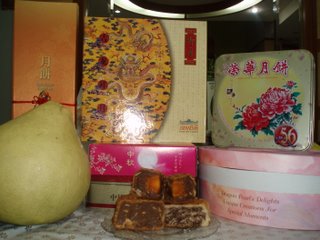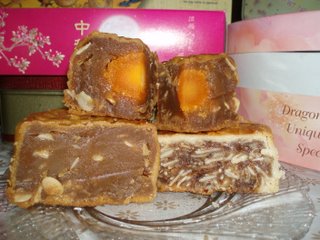 Cakes from the moon? Nay, mooncakes are inextricably linked with the Moon. Roughly the size of a human palm, the traditional ones are filled with lotus seed paste. These mooncakes are quite filling, meant to be cut diagonally in quarters and passed around. This explains their rather steep price (from S$5.00). A word of caution: the salty yolk in the middle, representing the full moon, is an acquired taste.
Cakes from the moon? Nay, mooncakes are inextricably linked with the Moon. Roughly the size of a human palm, the traditional ones are filled with lotus seed paste. These mooncakes are quite filling, meant to be cut diagonally in quarters and passed around. This explains their rather steep price (from S$5.00). A word of caution: the salty yolk in the middle, representing the full moon, is an acquired taste.More elaborate versions of mooncakes contain four egg yolks (representing the four phases of the moon). Besides lotus seed paste, other traditional fillings include red bean paste and black bean paste. Unfortunately for dieters, mooncakes are rather high in calories.

Mooncakes come in various shapes & sizes, and have different fillings.
While in the past mooncakes took up to four weeks to make, automation has speeded up the process considerably. Today, mooncakes may be filled with everything from dates, nuts, and fruit to Chinese sausages. More exotic creations include green tea mooncakes, and ping pi or snowskin mooncakes, a Southeast Asian variation made with cooked glutinous rice flour.

Mooncakes with various fillings - my sister-in-law made the Lotus seed paste mooncakes every year while friends & business associates send me boxes of them!
Haagen-Daz has even gotten into the act by introducing a line of ice cream mooncakes. Given the difficulty of making them, most people prefer to purchase their mooncakes instead of making them. Bakeries begin selling them around mid-August.
The Mooncake festival is a different way to celebrate the Mid-Autumn harvest moon.
The Mooncake festival (also called Mid-Autumn festival or Lantern festival) falls on October 6 this year. Chinese people celebrate the Mid-Autumn festival with dances, feasting and moon gazing. Not to mention mooncakes.
 Lanterns & sparkles are the kids' favourite toys during Mid Autumn Festival.
Lanterns & sparkles are the kids' favourite toys during Mid Autumn Festival.What is the Mooncake festival? Every year on the fifteenth day of the eighth month of the lunar calendar, when the moon is at its maximum brightness for the entire year, the Chinese celebrate zhong qiu jie.
 Pomelo is a must for celebrating the festival.
Pomelo is a must for celebrating the festival.Children are told the story of the moon fairy living in a crystal palace, who comes out to dance on the moon's shadowed surface. The legend surrounding the "lady living in the moon" dates back to ancient times, to a day when ten suns appeared at once in the sky. The Emperor ordered a famous archer to shoot down the nine extra suns. Once the task was accomplished, Goddess of Western Heaven rewarded the archer with a pill that would make him immortal. However, his wife found the pill, took it, and was banished to the moon as a result. Legend says that her beauty is greatest on the day of the Moon festival.
According to another legend, on this day the "Man in the Moon" was spotted at an inn, carrying a writing tablet. When questioned, he said he was recording the names of all the happy couples who were fated to marry and live happily forever after.
Accordingly, just as June is the traditional month for exchanging nuptials in the west, many Chinese weddings are held during the eighth lunar month, with the fifteenth day being the most popular.
Of course, the most famous legend surrounding the Moon festival concerns its possible role in Chinese history. Overrun by the Mongols in the thirteenth century, the Chinese threw off their oppressors in 1368 AD. It is said that mooncakes - which the Mongols did not eat - were the perfect vehicle for hiding and passing along plans for the rebellion. Families were instructed not to eat the mooncakes until the day of the moon festival, which is when the rebellion took place.
Hello!
ReplyDeleteThanks for visiting my site, the works of "Arte Urbano" are in several European cities, especially British.
Good work with this blog!
Greetings.